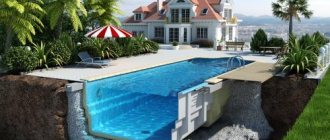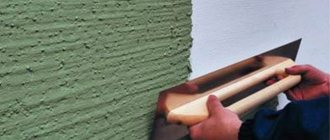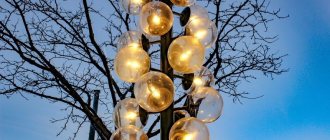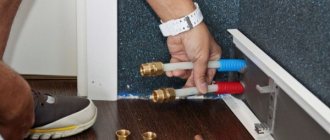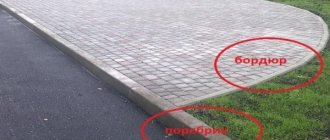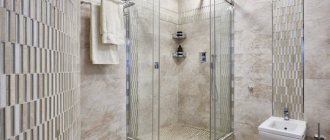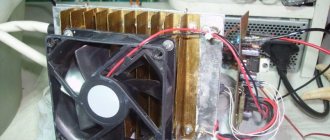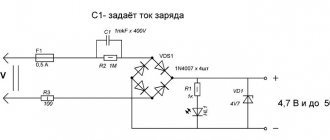8378 0 1
Vadim June 13, 2017
What façade putty for exterior use is currently on the market? Let's find out together what types of putty exist, what these or other compounds are used for, and what brands make a quality product. And for the DIYers, I’ll tell you how to putty the facade of a house for painting with your own hands in two ways.
Puttying the facade is one of the main stages of home improvement.
Purpose of putty for the facade
Leveling walls is one of the most labor-intensive and important processes in facade finishing. Without it, many other works on decorating the exterior of the house become simply impossible. For example, plastering the surface can only be done on perfectly smooth walls, and laying and gluing insulation onto an unprepared base is impossible.
The words putty or putty come from the German word “Spachtel” - spatula; the use of both options is quite acceptable, so in the following story you will be able to see both. In addition to leveling, putty performs another important function - sealing potholes and cracks in the wall. This is what it was originally used for.
Leveling a brick wall
Requirements for facade putty material
Based on the purpose of façade putty, it has a number of requirements that must be taken into account when purchasing.
- Plastic. This property is characteristic of a high-quality solution. If the material does not have it, then there is a serious danger of cracking of the coating and its destruction from atmospheric vibrations.
- Vapor permeability. The most important property of all types of facade finishing materials should also be in the putty. If it is missing, then the fumes will accumulate under the leveling layer and destroy it from the inside.
- Moisture resistance. The ability to repel atmospheric moisture and not allow it to pass inside protects not only the putty coating itself, but also the facade of the house. Water can remain in the pores, and when frozen, expand and destroy it.
- Frost resistance. Cracking from frost or seasonal temperature differences can also affect the main covering of the wall, so frost resistance is a very important quality for a putty mortar.
Materials and tools for puttying
Classification of façade putties by purpose
According to their purpose, they are divided into starting and finishing. There are also universal putties that combine the properties of both putties, but they are most often used for interior finishing.
Starting putty is characterized by a coarse grain texture and is used, as the name suggests, for preliminary leveling. It has good adhesive properties, is easily processed with sandpaper, and has good mechanical strength.
The starting façade putty is applied with a thickness of 2 to 20 mm. Subsequent applications are made after the previous ones have completely dried, with sanding in between layers.
The finishing façade putty is much finer than the starting putty. Gives a smooth and even surface to be processed. Quite fragile. The thickness of the applied layer should not exceed 5 mm.
The requirements for facade putties are as follows: they must have elasticity, allow air to pass through, not allow moisture to pass through, and should not be afraid of temperature changes.
Classification of putties by purpose
All putties for facade work are divided into two types: starting and finishing. Usually both are required. Before purchasing, inquire about the purpose and type of material so as not to buy unnecessary things. In addition, you need to decide which putty you need more and in what quantity.
Starting
The structure of this composition should be coarse-grained and have increased strength and high adhesiveness. It smooths out the main unevenness of the wall, seals structural cracks and potholes on the facade that require repair. Often used to eliminate uneven masonry or defects in concrete walls. The composition can be applied in a fairly thick layer - up to 4 mm. For strength, particles of marble dust and lime are often added to the starting mixture. They give it the necessary elasticity and adhesion to the surface of the building. Most often, cement compounds are used for the starting layer, and polymer binders give the putty elasticity.
Attention! When purchasing a starting putty mixture, make sure that it is intended for facades. It is unacceptable to use compositions for interior work on exterior walls.
Starting putty
Finish
The final putty coating must be plastic, smooth, waterproof, have good adhesion and strength. Most often, a mixture based on acrylic or silicate binders is used - they are more consistent with the goal of creating a smooth and uniform layer. Finishing putty is used to level the surface, and therefore the particles it consists of must be small.
The finely dispersed structure allows you to create a perfectly even base for future decorative coating. Experienced finishers recommend applying the finishing putty in several steps with a layer of about 3 mm. Do not use mixtures for leveling coating that are difficult to mix with colors. If in the future you are going to finish the walls with decorative plaster or paint, then it is better to tint the finishing putty in the appropriate shade, otherwise it may show through the main finish.
Types
Which putty is best for walls under wallpaper? According to their purpose, putties are divided into the following types.
Starting
It is used for the purpose of premature leveling of the entire area on which installation will take place. There is one significant difference between the starting and finishing putty.
The starting mixture dries out in just a few minutes and in the future it will be almost impossible to correct any defects or irregularities.
Starting
Finish
Finishing putty under the wallpaper is used at the end of the work to fix the result and level the surface. This putty is applied only after the previous layer of putty has dried well. Here we talk about how long it takes for the putty to dry.
If you carry out additional processing, you can end up with an improved wall, smooth and without the slightest damage.
Finish
Their composition is as follows.
Cement
Used for repairs indoors for painting or outside. Here's about finishing putty for painting. The material is suitable for finishing rooms with high levels of humidity.
Cement
Plaster
May only be used in completely dry apartments . If gypsum putty is used for rooms where there is high humidity, the material will begin to crack instantly.
Plaster
Acrylic
Acrylic putty is used to perfectly level the walls. Here about acrylic wood putty.
Acrylic
Also, putties can also be divided into the following types:
- ready-made, which are sold in stores;
Ready to use
- dry, in powder form .
Dry mix
The advantage of the first type of putty is that after opening the package, the master can immediately start working.
Finishing putties can also be divided into further subgroups.
Latex
Latex acrylate mixture is one of the most popular on the market.
This putty is used for almost all materials; it adheres well, does not crack and lasts for many years.
Latex
But keep in mind that latex putty is quite expensive. Typically, purchased packages contain twenty-five kilograms of putty.
Oil-adhesive
Oil-adhesive putty material has been used for a long time. However, this method of application has not lost its properties today.
The material is distinguished by its high density, and therefore the weight becomes much greater. The mixture is best suited for finishing indoor floors.
Oil-adhesive
If you let the putty harden for some time, the layer becomes very durable and of high quality. In stores, one unit package contains five hundred grams of putty.
PVA
Putty containing PVA is usually used to finish those surfaces in which there is a risk of fungus or other bacteria .
PVA
You can purchase the mixture at a hardware store in the form of a small bottle.
Types of facade putties based on the base
The building materials market offers a wide selection of putty compounds. Manufacturers, prices, types of mixtures can confuse any inexperienced finisher. Let's try to understand the main types.
Reinforcing mesh under cement
Cement
Such putties are considered the best for applying a starting layer and for filling cracks and potholes in the wall. Cement-based mixtures usually consist of cement, lime flour with fractions of 0.2 mm, quartz sand and marble dust. To improve the performance, chemical additives are added to it. The surface covered with starting cement putty looks perfectly smooth, but is quite rough due to the coarse-grained structure of the material. The finishing cement putty has a finely dispersed structure and comes in several colors: gray, beige and yellow. White cement putty is almost impossible to find these days. Since its bleaching requires expensive compounds, which increase the cost of the finished mixture. It is available in the form of powders and ready-made mixtures in buckets. Liquid material also has disadvantages.
- The strong shrinkage of the dried mixture must be taken into account when sealing cracks.
- If the liquid cement composition is applied in a thick layer, then the likelihood of cracking is very high.
In order to prevent the destruction of the cement coating, a reinforcing mesh is applied during the work.
The advantages of cement compositions outweigh their minor disadvantages.
- Ease of use allows even an inexperienced finisher to work with it.
- Cement is a durable material and guarantees high levels of frost resistance, density and weather resistance.
- It has an affordable price, and therefore is very suitable for treating large surfaces, which is typical for building facades.
Important! Never mix cement putty with varnishes, paints and glue so that it does not lose its properties.
Grain size of cement finishing
When purchasing cement compositions, pay attention to the grade of cement, compressive strength and level of adhesion.
Plaster
Plastering with a gypsum mixture is one of the easiest ways to putty the surface of a facade. It is very easy to work with gypsum because it has a flexible, light structure and can be leveled well. Plastic makes it possible not only to easily level, but also to accurately form corners and perform other shaped work on the facade of a building. Positive aspects include good vapor permeability, frost resistance, smoothness, and easy coloring. The lack of shrinkage allows you to make a layer as thick as you like and apply it in one go.
But there are also negative sides. If you live in rainy, humid areas, it is better to use gypsum to a minimum, as it absorbs moisture quite well and can be destroyed under its influence. On the other hand, the gypsum mixture dries out very quickly, so working with it under the scorching sun is not recommended.
When purchasing gypsum plaster, pay attention to the manufacturer. It is better to take proven brands. This way you will protect yourself from rapid damage to the facade and will be confident that the mineral additives contained in the composition are of high quality, which means the coating will last longer.
Gypsum plaster can be applied in one layer
Acrylic
These finishing materials come in starting and finishing materials. Having all the necessary properties, acrylic mixtures can and should be used for facade work. They are sold ready-made, which makes their use even easier. Facade putty made of acrylic has good adhesive properties, but it is applied to a previously primed surface, since the putty layer is quite thin. The only disadvantage of acrylic mixtures is that the higher price compared to previous products does not allow it to be used over large areas as a starting layer. Most often it is used for finishing.
Latex and acrylate
These types of putty materials are designed for extreme conditions and therefore are used for outdoor work. They are even more moisture-resistant and frost-resistant than conventional acrylic composition. Its durability and ductility have earned recognition from builders and finishers around the world. Latex and acrylate do not crack when dry and do not shrink. High adhesive properties make it possible to further strengthen the protection of building walls and make the bond with the subsequent decorative coating more durable. Latex mixtures come in a variety of colors and therefore do not require additional coloring. The thinnest layer of this composition forms the ideal finishing coating. There are such starting and finishing plasters, but their too high price is their main drawback.
Colored latex putties
Types of putty based on the base
Since all types of facade putties are assigned the functions of a protective barrier, they must have a fairly reliable base. For this purpose, cement or polymer components are used. Let's take a closer look at both options:
Cement-based putties
Facade cement putty is characterized by high resistance to moisture and low temperatures.
In addition, it has good strength, so it almost never cracks when dried. For the production of cement-based starting putty mixtures, quartz sand, crushed to 0.5-0.6 mm, is used. The composition of the finishing facade putty may include the following components:
- limestone flour with granule sizes up to 0.2 mm;
- ground quartz sand (marshallite);
- marble dust (microcalcite).
To improve the technical characteristics of this finishing material, its composition is enriched with chemical additives. Cement putty for facade surfaces can have a beige, yellowish or gray tint.
White cement putty is currently not produced because expensive bleaches must be used for its production.
Before purchasing cement-based putty, craftsmen recommend paying attention to the following aspects:
- brand of cement;
- compressive strength;
- level of adhesion with the material that will be finished.
Polymer-based putties
Polymer binders serve as the basis for a whole range of façade putties. All of them can be conditionally divided into two large groups:
- Acrylic putties. All brands of acrylic putties are made on the basis of acrylate-siloxane mixtures. They are excellent for both basic and finishing finishing of external surfaces of buildings and structures. Acrylic-based mixtures do not need to be diluted with water; they are easy to apply and easy to process. After laying, the material is leveled to a thin layer approximately 2 mm thick.
- Latex putties. This type of polymer putty is not used for finishing facades.
All putties for exterior use that have a polymer base have a number of advantages:
- strength;
- durability;
- plastic;
- fast setting;
- no shrinkage;
- no smell.
The disadvantage of such putties can be considered incompatibility with some types of building materials. Most often, polymer putties are used for finishing surfaces made of cement, concrete, gypsum or plaster mortar.
There are also special mixtures used, for example, for finishing polyurethane.
How to choose the right putty for the facade
The characteristics of the putty and knowledge of which material is best to apply in certain cases will help you make the right choice.
- When insulating a facade with polystyrene foam, polystyrene foam or polyurethane foam, it is better to use latex and acrylic texture. Use the same types of finishing mixtures when walls have poor permeability, for example, on concrete or metal.
- If you live in cold zones where frost is a frequent visitor, then use a special frost-resistant putty.
- Do not use oil-based products for facade work, but if you do purchase them, remember that you will only have to paint them with oil paint, since other paints will not adhere to drying oil plaster. But if your house is made of wood, then oil-based façade putty is a good choice.
- Try not to use materials from different manufacturers, price categories and types. If you started working with one, try to finish the process of puttying the walls with the same composition. Remember that the materials may not be compatible with each other! It is for this reason that it is better to immediately calculate the quantity of the product and assess your financial capabilities.
- When calculating the amount of material, proceed from the thickness of the layer you need to apply. The thinner the coating, the less putty is consumed.
Dry polymer cement plaster mixture
Main manufacturers and prices
- One of the most recognized manufacturers in the building materials market is Ceresit. Polymer-cement plasters from this manufacturer are distinguished not only by their high quality, but also by their low cost. They are made from a cement-sand mixture with the addition of polymer additives and synthetic fibers for plasticity. These mixtures are characterized by high vapor permeability, fire safety, long shelf life, and cost-effectiveness. In addition, Ceresit putties differ from many in color. These are white mixtures, which is rare among cement compositions.
- Synthetic plasters from this company are produced in finished form and meet the requirements of facade materials. Acrylic, acrylic resin-based, polymer silicate and polymer silicone compounds are used for finishing walls. They are characterized by increased resistance to deformation, moisture resistant and elastic. You can study the properties of acrylic materials from the photo in the table.
- The global manufacturer of building materials, Knauf, has a strong position in the sale of plaster and putty compositions. It produces finishing cement mixtures in dry form, which significantly saves money on facade finishing. A 25 kg package of multi-finish cement mixture costs about 600 rubles.
Characteristics of acrylic putty materials Ceresit
has proven itself well in the domestic market. It offers various facade mixtures at low prices with good quality. Weber Vetonit finishing putties have been in demand for many years. This dry polymer product for facade work has a low cost - about 600 rubles.
Multi finish Knauf
Classification of façade putties by composition
They are divided according to their composition into two main types:
- cement-based;
- polymer based.
Cement facade putties are characterized by frost resistance and good waterproofing ability. They contain quartz sand, fine marble dust, cement, as well as various modifiers to improve properties.
They are relatively inexpensive. The disadvantages are the shrinkage of the putty when drying and the possibility of cracks appearing on the facade of the building due to its relatively low elasticity.
Polymer façade putties can be based on acrylic or latex.
Both starting and finishing mixtures are made from acrylic. The advantages of acrylic are its plasticity, lack of shrinkage upon drying and immunity to temperature changes, mechanical strength and ease of use. Acrylic putties are used to protect concrete, foam concrete, and plaster.
Before applying the composition, it is necessary to prime the surface to be treated. The disadvantages are thin intermediate layers (1-3 mm) and the need to sand the intermediate layers in respiratory protective equipment.
Latex, like acrylic, is used to make both starting and finishing putties. It is produced in the form of a ready-to-use paste, does not emit unpleasant odors and is non-toxic. The resulting surface is characterized by strength, ductility, long service life, and is not prone to cracks. The only downside is the high cost of the material.
Finishing work
Technology for applying starting putty
The simplest and most popular method is beacon plaster.
- First of all, it is necessary to prepare tools that may be useful at this and subsequent stages.
Plastering tools
- The next important step will be preparing the wall. It is necessary to tap the surface for potholes. This is best done with a wooden or rubber hammer. After this, the surface is cleaned of excess dust and remnants of the old coating. If the wall has been painted or plastered, then everything must be cleaned.
Stripping the wall of old coating
- The next step is to install beacons. Using mortar and a building level, we install metal or wooden slats 1-2 cm wide (beacons) at a distance of 20-30 cm from each other. Next, we stretch the cord between the beacons.
Installation of beacons
- It's time to prepare the solution. First of all, read the instructions! Usually the powder is poured into water, and not vice versa. Beat the solution with a special attachment on a drill and leave for 10-15 minutes. Next, beat again.
Preparation of the solution
- We begin to plaster the wall. To do this, take a trowel in your right hand, and in your left hand, throw the mortar onto the wall with a sharp movement. After this, use a trowel or grater to rub the putty mixture over the surface.
Grouting the mixture
The whole process is clearly shown in the video. Pay attention to the technique of throwing the mortar onto the wall.
Plastering walls on beacons
Finishing putty process
The technology for finishing with finishing putty material is similar to working with a starting solution. After the starting layer has completely dried, apply the finishing layer in the same way: using a trowel, apply the mortar to the wall and rub it in. The only difference is that the thickness of the coating is minimal, and the rubbing must be very thorough, since this process is followed by the application of a decorative coating. You can use several methods of grouting putty: in a circle and in a running manner.
When finishing, it is important not to interrupt the process of processing the wall. Try to calculate the time for finishing entire sections of the facade.
Methods for grouting putty
As you can see, façade putty can be applied with your own hands; all you need is a little patience. By preparing walls for decorative finishing yourself, you significantly save money, which you can spend on higher quality material.


